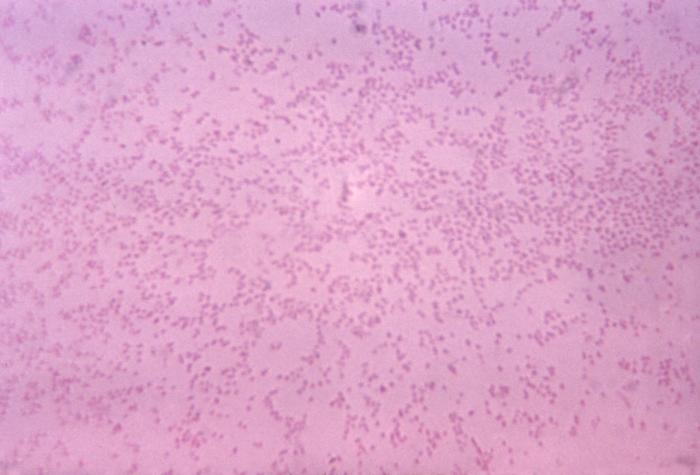Pasteurella multocidaPasteurella multocida is a Gram-negative, non-motile, non-sporulating, coccobacillus bacterium found in the oral flora of many animals and the frequent cause of local infection after bite injuries (Figure 1). This pathogen is aerobic to facultatively anaerobic and occurs worldwide, with cats being the source of 60% to 80% of human infections. Alongside local wound infections, P. multocida is the causative agent of fowl cholera, which is an infectious disease of poultry and other birds.
Figure 1. This micrograph depicts Pasteurella multocida, using a Gram-stain technique [1125 X]. Metabolic and biochemical properties important for the identification of P. multocida include indole and hydrogen sulfide production, chemical reduction of nitrate, ability to growth on potassium cyanide, and the presence of the enzyme ornithine decarboxylase. Moreover, virulence factors include lipopolysaccharide (LPS), capsule proteins, and homologues of Bordetella pertussis filamentous hemagglutinin. Recall that the binding of filamentous hemagglutinin to macrophages leads to phagocytosis of the organisms without oxidative burst associated with phagocytosis, thus allowing the survival of the bacteria inside host immune cells. Another virulence factor includes P. multocida toxin (PMT), an unusual toxin that acts as a mitogen by stimulating various intracellular signaling cascades (Laxa & Grigoriadisb, 2001). Pathways downstream of the G-protein and also downstream of the Rho (ρ)-proteins (proteins that regulate the assembly of actin) are activated. Thus, PMT action stimulates phospholipase C leading to activation of protein kinase C, an increase in inositol phosphates, and a rise in intracellular calcium. As mentioned, Rho activation of the Rho kinase leads to cytoskeletal reorganisation, tyrosine phosphorylation of the focal adhesion kinase, and activation of the Src proto-oncogene. In addition, signaling through the Ras-MAP kinase signaling pathway is also initiated. Thus, PMT is an intracellularly acting toxin that is likely to cause certain complications during P. multocida infection (Laxa & Grigoriadisb, 2001). Generally, all age groups are susceptible to infections caused by P. multocida; however, infections are predominantly noted in patients with underlying chronic disorders, in elderly patients or in infants less than one year. This germ is capable of targeting a wide array of organs in the body, including the lungs, central nervous system, intestines, eyes, heart, and lymph nodes. The characteristic physical attribute associated with P. multocida infection is the formation of abscesses - localized accumulation of pus in a body tissue. At the local level, an individual bitten by an infected animal may also experience erythema, pain, purulent discharge, lymphangitis, joint swelling, and decreased range of motion. Infections targeting the respiratory system may cause sinus tenderness, hoarseness, pharyngeal erythema, and changes in vocal fremitus. If the pathogen spreads to the ocular and periocular structures, corneal ulcers may result, causing decreased visual acuity, while targeted cardiovascular muscles may cause hypotension, tachycardia, or cardiac murmur. The bacteria may also cross the blood-brain barrier and cause meningitis. Regardless of the infection, a high leukocyte and neutrophil count is typically observed, leading to an inflammatory reaction at the infection site. This species can be effectively treated with β-lactam antibiotics, which inhibit cell wall synthesis. It can also be treated with fluoroquinolones or tetracyclines; fluoroquinolones inhibit bacterial DNA synthesis and tetracyclines interfere with protein synthesis by binding to the bacterial 30S ribosomal subunit. Because P. multocida is most often acquired as a result of a bite (most notably a cat), infections are frequently polymicrobial and involve anaerobic bacteria. As a result, amoxicillin-clavulanate (a β-lactamase inhibitor/penicillin combination) is seen as the treatment of choice. The organism is also susceptible to ordinary disinfectants, sunlight, drying, and heat. References: Laxa, A.J., & Grigoriadisb, A.E. (2001). Pasteurella multocida toxin: the mitogenic toxin that stimulates signalling cascades to regulate growth and differentiation. International Journal of Medical Microbiology. 291(4): 261-268. Haase, R., Stiefel, M., Merkel, N., Knopp, W., Sauer, H., & Lieser, U. (2006). Pasteurella multocida as a rare cause of neonatal meningitis. Zeitschrift für Geburtshilfe und Neonatologie, 210(6): 219-221. |

